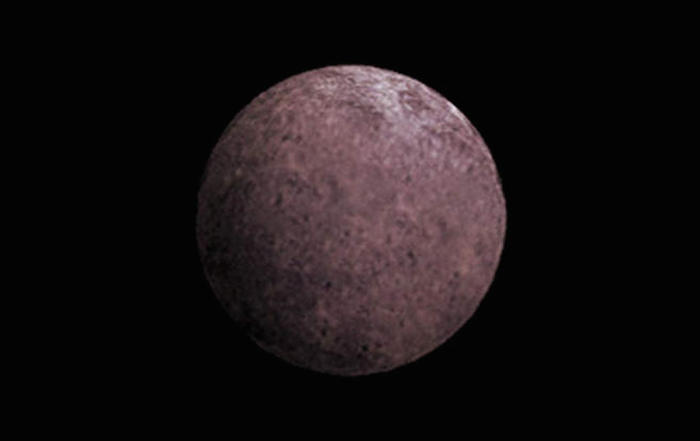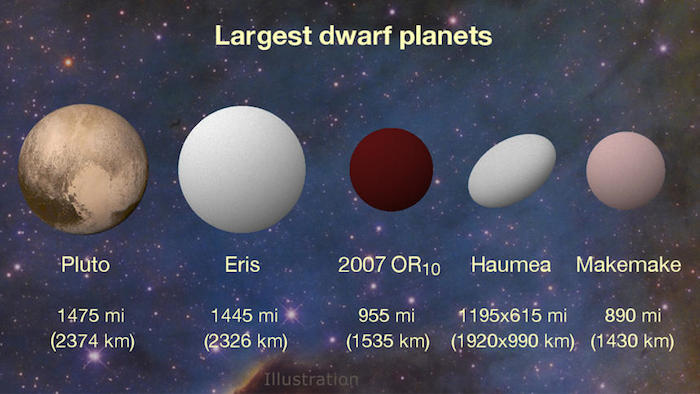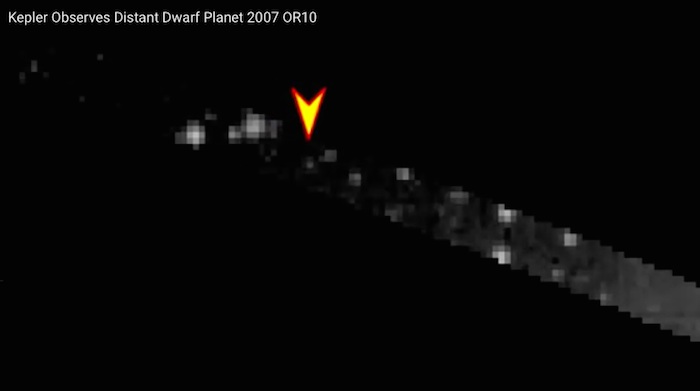.
A distant, dark new world is larger than we thought, and its surface could be covered with volatile ices, a new study finds.

An artist's conception of 2007 OR10. Astronomers suspect that its dark reddish colour is due to the presence of irradiated methane.
CREDIT: NASA
-
A mysterious dwarf planet orbiting the Sun out past Neptune is much larger than previously thought, a new study concludes.
At 1,535 kilometres in diameter (about a third smaller than Pluto and 250 kilometres more than thought), it is the largest unnamed body in the solar system and the third largest of the known half a dozen dwarf planets.
The body is known only as 2007 OR10.
NASA's Kepler spacecraft, its mission now known as K2, observed it for 19 days in late 2014 and, for the new paper, scientists combined that data with archival data from the infrared Herschel Space Observatory.
“K2 has made yet another important contribution in revising the size estimate of 2007 OR10,” said Geert Barentsen, Kepler/K2 research scientist at NASA's Ames Research Center in California.
“But what's really powerful is how combining K2 and Herschel data yields such a wealth of information about the object's physical properties.”
.

New K2 results peg 2007 OR10 as the largest unnamed body in our solar system and the third largest of the current roster of about half a dozen dwarf planets. The dwarf planet Haumea has an oblong shape that is wider on its long axis than 2007 OR10, but its overall volume is smaller.
CREDIT: KONKOLY OBSERVATORY/ANDRÁS PÁL, HUNGARIAN ASTRONOMICAL ASSOCIATION/IVÁN ÉDER, NASA/JHUAPL/SWRI
.
Being bigger than thought raises the likelihood that its surface is covered in volatile ices of methane, carbon monoxide and nitrogen, which would be easily lost to space by a smaller object.
“It's thrilling to tease out details like this about a distant, new world – especially since it has such an exceptionally dark and reddish surface for its size,” said András Pál at Konkoly Observatory in Budapest, Hungary, who led the research.
The object is also rotating more slowly than almost any other body orbiting our sun, and takes nearly 45 hours to complete a daily spin. Its elliptical orbit brings it nearly as close to the sun as Neptune, it is currently twice as far from the sun as Pluto.
.

K2 uses the same technique as the previous Kepler mission to spot exoplanets. It searches for the tiny, telltale dip in the brightness of a star can be the signature of a planet passing, or transiting, in front – as we saw Mercury do with our own Sun this week.
In the video, above, the apparent movement of the faint dwarf planet (indicated with the arrow) among the stars is caused by the changing position of Kepler as it orbits around the sun.
The diffuse light sweeping across is a reflection from the much brighter planet Mars passing nearby.
Figuring out anything about these small objects so far from Earth is tricky. Before the stunning images were taken in last year’s fly-by of Pluto by the New Horizon’s spacecraft, it was just a blurry blob to us.
As they appear as mere points of light, it can be a challenge to determine their size and depends on whether the light they emit represents a smaller, brighter object, or a larger, darker one.
The discovery of the very slow rotation by K2 was essential for the team to construct more detailed models that revealed the peculiarities of this dwarf planet.
The rotation measurements even included hints of variations in brightness across its surface.
Together, the two space telescopes allowed the team to measure the fraction of sunlight reflected by 2007 OR10 (using Kepler) and the fraction absorbed and later radiated back as heat (using Herschel).
Putting these two data sets together provided a clear estimation of the dwarf planet’s size and how reflective it is.
Naming rights for 2007 OR10 go to the object's discoverers – astronomers Meg Schwamb, Mike Brown and David Rabinowitz who first spotted it in 2007 as part of a survey to search for distant solar system bodies using the Samuel Oschin Telescope at Palomar Observatory near San Diego.
“The names of Pluto-sized bodies each tell a story about the characteristics of their respective objects. In the past, we haven't known enough about 2007 OR10 to give it a name that would do it justice,” said Schwamb.
“I think we're coming to a point where we can give 2007 OR10 its rightful name.”
Quelle: COSMOS
4542 Views
